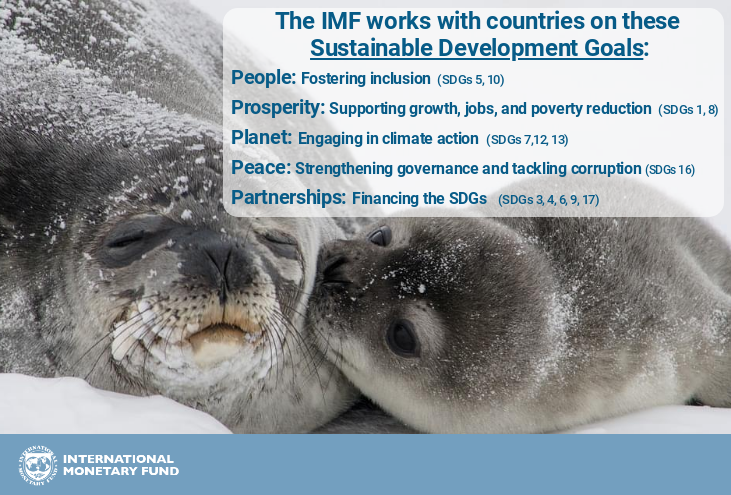July 26, 2018
Version in عربي , 中文, Español, Baˈhasa indoneˈsia, 日本語, Português, Русский
[caption id="attachment_24085" align="alignnone" width="1024"] The global economic juggernaut is bumping into the boundaries of environmental safety (photo: Infogram).[/caption]
The global economic juggernaut is bumping into the boundaries of environmental safety (photo: Infogram).[/caption]
Although we live in an age of unparalleled wealth and technological achievement, billions of people are still suffering from poverty, hunger, exclusion, and conflict. And the global economic juggernaut is bumping into the boundaries of environmental safety, including by changing the climate in a perilous manner through the burning of fossil fuels.
The Sustainable Development Goals (SDGs)—endorsed by 193 countries in 2015 as a blueprint for policy through 2030—represent a holistic response to this complex set of interrelated challenges. The IMF is engaged with the SDGs when they affect economic stability and sustainable and inclusive growth. Here are five things to know about how the IMF helps countries reach these goals, in the context of the five SDG pillars of people, prosperity, planet, peace, and partnership.
Billions of people still suffer from poverty, hunger, exclusion, and conflict.
- People: Fostering inclusion. Inclusion matters for the IMF’s mandate. This harks back to the IMF’s founding charter, which stresses the importance of maintaining high levels of employment—a key driver of social inclusion. More recently, our research shows that high levels of income inequality are associated with lower and less durable economic growth and greater financial instability. Likewise, evidence shows that reducing gender gaps boosts economic productivity, growth, and resilience. Both inequality and gender equity are now reflected in IMF policy advice whenever and wherever they are deemed important for economic stability and inclusive growth. So, the IMF has been exploring how fiscal policy can be deployed to reduce inequality—through spending on health, education, and social protection and ensuring the progressivity of tax systems. For gender, it is focusing on efforts to boost women’s economic participation, especially through the design of tax and spending policies—a practice known as gender budgeting.
- Prosperity: Supporting growth, jobs, and poverty reduction. Boosting growth, especially in low-income countries, is a vital precondition for SDG success. Here, the IMF is focusing on creating fiscal space for growth-enhancing and poverty-reducing investments in health, education, infrastructure, and agricultural productivity, as well policies to promote economic diversification. It is also exploring policies to address the challenges related to the future of work, given the disruptions brought about by technological change. This is especially important in the context of youth unemployment, the source of so much discontent across the world. The IMF is also in the process of reassessing its approach to social spending, a vital tool for reducing poverty and making growth more sustainable. For example, social protection is one of the pillars of the Argentinean reform plan supported by the IMF.
- Planet: Engaging in climate action. Few global challenges are more urgent and complex than the need to tackle climate change by moving to a zero-carbon energy system over the next three decades, which is what the Paris Agreement calls for. A necessary ingredient in this energy transition is making sure that energy prices reflect health and environmental costs, in terms of both carbon emissions and air pollution. Hence the IMF is helping countries with pricing carbon emissions and removing energy subsidies. It has also introduced Climate Change Policy Assessments to help highly-vulnerable countries like Seychelles and Lucia prepare for the effects of climate disruption. And it is stepping up quick disbursing emergency financing to countries hit by severe climatic shocks.
- Peace: Strengthening governance and tackling corruption. Strong institutions founded on good governance are the backbone of peaceful and inclusive societies, and a foundation upon which the other goals are built. The IMF is stepping up its work in this area. Finding that corruption and weak governance frameworks are associated with significantly lower growth, investment, FDI, and tax revenues, the IMF has rolled out a new framework that seeks a more systematic, evenhanded, effective, and candid engagement with member countries. At the same time, the IMF is also ramping up efforts to build capacity and strengthen institutions within countries—with a special focus on fragile and conflict-afflicted states, places where SDG implementation faces unique challenges.
- Partnerships: Financing the SDGs. The SDGs come with a price tag. Achieving them will require a significant increase in public spending in many countries. The IMF is supporting in several ways. On the spending side, it is developing a broad framework for assessing spending needs focusing in a number of country case studies—Benin, Guatemala, Indonesia, Rwanda, and Vietnam—in support of achieving some big-ticket SDGs—health, education, and infrastructure. This is being done in collaboration with country officials, the World Bank, and United Nations agencies. In terms of financing, strengthening tax capacity will be critical, especially since rising debt levels in low-income countries are complicating SDG progress. For most developing countries, however, domestic revenue alone will not be sufficient to fill the financing gap, which calls for stepped-up official aid and private financing options.
By articulating clear objectives for making development more sustainable and inclusive, the SDGs represent the basic requirements of human decency and flourishing, for this and future generations. Helping countries navigate this policy roadmap is a top priority—including for the IMF.





